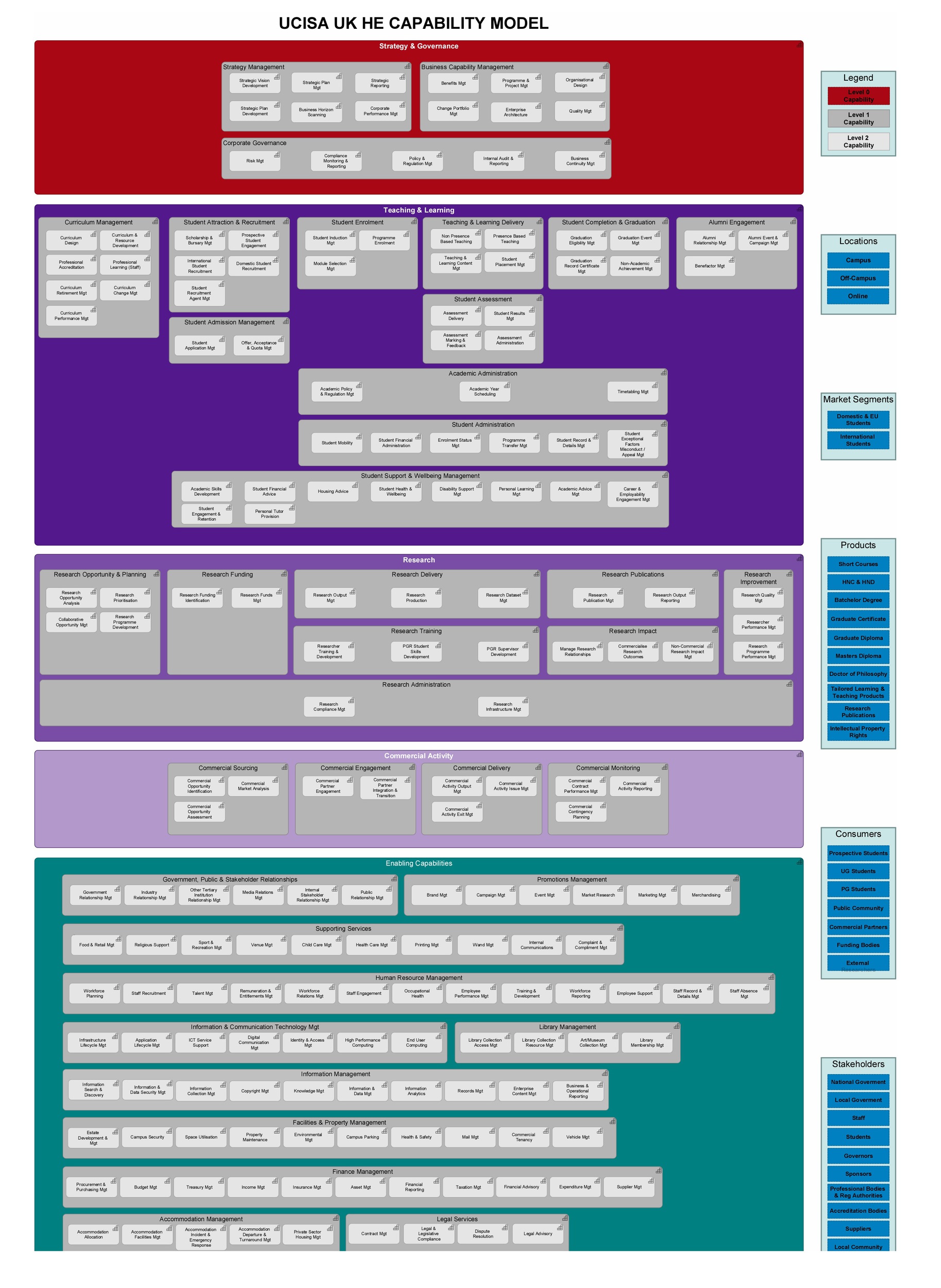The UK HE Capability Model recently launched by UCISA’s Enterprise Architecture Community of Practice defines and maps out, for the first time and in a simple, logical hierarchy, the core capabilities necessary for any institution to operate effectively in the UK sector.
Developed over a year with input from five universities and HESA representatives, the Model will resonate with anyone responsible for the IT, data, applications or technical architecture that form the digital backbone of a modern institution.
It also provides a valuable new tool for all those responsible for institutional change at both strategic and operational level – from enhancing capabilities directly supporting student learning and student satisfaction to understanding where GDPR-related data sets are created so they can be better managed and governed.
The Model’s holistic view of capability relationships helps university policy makers and planners better understand the impact of change on the value offered to all stakeholders. That value may often be around cost or efficiency but can also encompass wider business objectives such as meeting strategic goals, shaping culture, people development or improving student wellbeing.
Making change work
It’s said one of the biggest challenges for senior managers is having confidence that the change investments they are asked to sign off will make a real difference. This is particularly true in digital transformation and IT architecture where sums can be vast and business cases supported by endless, and to the relative layman, impenetrable technical detail.
Having a common, cross-institution language for capabilities, defining capability owners, seeing capability relationships and grouping data around capabilities engenders common understanding and a shared overview.
With nine out of ten IT decision-makers claiming legacy systems prevent them from harnessing digital technologies to support growth and efficiency, the ability to talk around capability outcomes rather than ‘tins and wires’, builds wider regard for IT as a principle enabler for business innovation with a central role in strategy.
That’s vitally important at a time when universities are, for better or worse, operating in an increasingly marketised environment. Adapting, evolving and offering new and unique value propositions, sometimes beyond ‘Mother’ campus boundaries, need processes to be ever faster and more efficient. The UCISA model now offers a unique window on current state that allows for greater understanding of potential future desired states and the ripple effect of change investment in one capability across others.
Interchangable tools
Capabilities, by their nature, are unchanged over time. What alters are methods of delivery. Universities still teach, still conduct research but both have, and are, being transformed by digital technologies. The model allows us to examine the building blocks of those capabilities and, in the case of IT, to take account of the combined needs of multiple change programmes on the processes and applications supporting them.
That can open new, more-informed, discussion of the kind of IT strategy best suited to real needs and pressures on institutions to be more flexible and agile. For example, large ‘off-the shelf’ student record systems, HR systems and finance systems are designed to work in a homogenised way. As such, they may often be too rigid to support new ways of working. Necessary customisation of ‘one size fits all’ is costly, soaks up time and resource and makes it difficult to undertake updates and patches from suppliers.
By identifying the applications and processes underpinning capabilities it is possible to rationalise them. With that comes the opportunity to consider component-based hybrid systems consisting of built, shared or purchased elements. Like the separate Amp, Tuner and CD players of old hi-fi systems, these can be best of breed and more cheaply and quickly swapped out for the equivalent of the latest MP3, DAB or Wi-Fi streaming functionality.
As Chair of UCISA’s Community of Practice for Enterprise Architecture and project leader for the UK HE Capability Model, my hope is that it will not only spur new discussion about how each capability should best be delivered but also a new lens on collaborative approaches to change that fully meet the needs of the modern dynamic university.














I would like to be involved in the community of practice for sure particularly learning and discussion implementation and how to innovate
Hi Anne, thanks for the comment. If you are working within the HE or FE sectors you can be part of the EA CoP by joining our mailing list – details can be found here https://www.ucisa.ac.uk/groups/cop/ea
Always good to have new members and fresh input.
Ian
I work in Amue (a sharing-services HE French public agency). I was overjoyed to read your article about the UK HE capability model ! We are currently trying to do the same in France with a group composed by universities and research organisations
Hi Valerie, many thanks for your comments. I will will forward you some related info on how we ran the project in the UK which might be of use to you.
Ian
Excellent model. Curious, though, as an education leader in the U.S., I wonder how this model would need to be adjusted to not just be “UK-specific” – can you comment on this please?